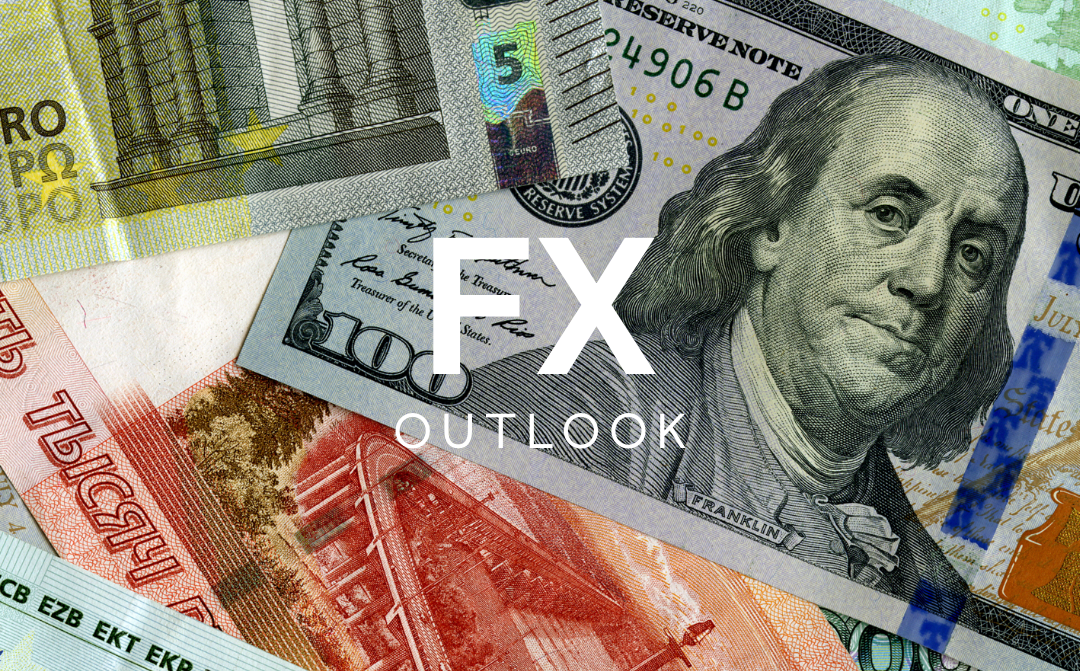20 Nov FX outlook – USD, EUR, GBP, CAD, AUD, NZD

Table of Content
USD
The US dollar was the big loser of the week, with falling inflation re-enforcing the recent risk-on flight from safety as the odds of a final hike from the Fed fell to just 1%. The Dollar Index (DXY) which tracks the dollar’s performance against a basket of currencies fell about 1.88% during the week, with particularly notable losses against AUD, EUR, and GBP.
The US inflation report represented the major highlight of the past week, with equity markets boosted from a greater-than-expected decline in CPI. The headline inflation rate fell from 3.7% to 3.2% (year-on-year), while an October slump in energy prices helped drive the monthly figure down to 0.0% from 0.4%. The core inflation figure (excluding Food and energy) continued to tread its more gradual path lower, slipping by 0.1% to 4.0%. With PPI factory price inflation similarly heading lower the US dollar saw plenty of selling pressure as markets dampened expectations of an additional hike.
Looking forward to a busy calendar this week for the US dollar, investors will anticipate Tuesday’s FOMC meeting minutes for more monetary policy insights. The Fed has remained cautious by embracing a rate pause at its last two policy meetings, citing the need to monitor inflation and the labor market. The current deceleration in inflation has seen the market already pricing in on another rate pause at December’s policy meeting and expectation of rate cuts by the first quarter of 2024. Further hawkish comments on the need to keep the door open to more rate hikes from the minutes on Tuesday would likely impact the US dollar positively. Alternatively, a dovish tone would be expected to sustain the current risk-on theme that could put the US dollar under pressure once again.
EUR
The euro ended the week as one of the top performers this week as it took advantage of the US dollar’s misfortune triggered by falling inflation figures which drove up risk appetite across the markets. As a result, the EURUSD gained of 2%, breaking through the 1.0900 level for the first time in over two-months. The euro also saw sharp gains against the Canadian dollar on the back of sharp declines in the energy space.
Several economic indicators released during the week in the absence of top-tier data sustained the EUR strength as optimism around the eurozone economy returned. Employment change for the third quarter experienced an increase to 0.3%, beating estimates. Meanwhile, the second estimate of third quarter GDP remained stable at -0.1%. The ZEW economic sentiment for Germany recorded another increase in the November survey to 9.8 while the eurozone figure increased to 13.8. The eurozone final core CPI y/y and CPI y/y remained unchanged at 4.2% and 2.9% respectively, confirming the recent declines evident in eurozone price gains. This has helped lift expectations that the ECB are likely to start eyeing cuts mid-2024. We also saw the latest European Commission forecasts, with growth downgraded thanks to high inflation, high-interest rates, and weaker external demand.
The coming week is expected to begin much like the previous one, with the euro being influenced by disinflationary pressures. Investors are eagerly awaiting the release of flash PMI throughout the region, which could negatively impact the currency if the reports continue to indicate contractionary levels. Additionally, the euro will likely see volatility as we watch for commentary from ECB President Lagarde on Friday.
GBP
The pound experienced a somewhat topsy turvy week just gone, with the gains seen over the course of Monday and Tuesday eroded over the following three sessions. The currency managed to gain traction against a number of key currencies, with GBPUSD, GBPCAD, and GBPJPY all pushing higher. However, those gains were offset somewhat by a largely mixed performance against the euro Australian dollar and New Zealand dollar.
Last week saw a huge amount of economic data released for the UK economy, beginning with Tuesday’s jobs report. An unwelcome surge in claimants came alongside a higher-than-expected average earnings figure, strengthening the pound on the idea that the Bank of England may need to tighten further. Wednesday saw that hawkish sentiment eradicated after a lower-than-expected headline and core CPI reading. The decline from 6.7% to 4.6% for the headline figure does help bring the UK inflation back towards the current norms found elsewhere in the western world. With Friday’s retail sales figure of -2.7% coming in below expectations, we are seeing signs of economic weakness alongside disinflation. All in all, that makes for a rather pessimistic environment for GBP bulls.
Looking ahead, Bank of England governor Andrew Bailey makes an appearance on Monday, with markets keen to focus on the timing of the initial 2024 rate cut after recent data. With inflation expected to move back towards target by May, markets currently price an initial hike in June. Wednesday brings an Autumn budget from the chancellor Jeremy Hunt, with the pound likely to be volatile around any particular policy shift that enhances or inhibits growth. Finally look up for Thursday’s manufacturing and services PMI releases, with any additional signs of weakness likely to raise questions on whether the Bank of England would bring forward their easing process in the event of a sharp contraction in economic data.
CAD
The Canadian dollar closed the week with losses against other major currencies excluding the US dollar as it was heavily impacted by sharp declines in the energy markets. With concerns around demand, elevated inventories, and easing tension across the Middle East, we saw WTI drop below $73 for the first time since July. From a data perspective, the Canadian dollar was left at the mercy of other market movers as it relied on light data for support.
Signs of disinflation in the Canadian economy has sparked suggestion that the Bank of Canada might hold back on further rate hikes. The latest monthly manufacturing sales figure slid to 0.4% from the previous of 1.0%. Meanwhile, wholesale sales fell to 0.4% from 1.8%. Housing starts continued its uptrend in October, rising to 275,000 compared to the previous 271,000. Finally, Canada’s raw material prices experienced a decline in October to 2.5% from September’s revised figure of 3.9%.
Moving forward, the Canadian Dollar (CAD) is expected to be impacted by some major economic events slated to take place during this week. The focus will be on the Canada CPI report, which will have a significant impact on the currency’s performance in the market. If the report falls short of analysts’ expectations, the CAD could lose value as the possibility of further rate hikes by the Bank of Canada (BoC) reduces. Additionally, investors will closely monitor the comments made by the BoC Governor for more clarity on the rate outlook. Other reports that will influence the CAD include retail sales data and new home sales data.
AUD
The Australian dollar was one of the big out performers over the course of the week just gone, with disinflation in the US and Europe helping to drive down differentials. With markets feeling more optimistic, the Australian dollar also benefits from risk on appetite on the perception of pro-growth monetary policies coming into play next year. The AUD managed again ground against all its major peers, with AUDNZD strength also serving to highlight its regional outperformance.
Sentiment around the Australian dollar has been guided significantly by the November rate hike at the RBA. With inflation continuing to remain a problem in Australia, the strength of the economy does provide the backdrop for potential additional hikes from the central bank. Last week saw a strong wage price figure of 1.3%, highlighting the underlying inflation pressures within the economy. That was further reiterated by the inflation expectations figure which rose to 4.9% from 4.8%. However, the bumper employment change figure of 55K, and depressed unemployment rate of 3.7% do highlight the strength against which the RBA has felt emboldened to tighten further.
Looking ahead, keep a close eye out for the latest comments from RBA Governor Bullock, followed by the RBA minutes. The Australian dollar will remain volatile as we look for signs of further tightening from the bank. Meanwhile, the health of the economy comes back into focus on Wednesday, with the manufacturing and services PMI figures due out. With both currently below the key 50 threshold that separates a sector in contraction vs expansion, any further weakness could dampen rate hike expectations to the detriment of the AUD.
NZD
The New Zealand dollar similarly enjoyed a bumper week, although the strength seen within Tuesday’s risk-on play had faded into the next week. While that risk-on move helped see NZD outperform the havens, we also saw it strengthen against the likes of the Canadian dollar, euro and pound. However, those gains have been tempered somewhat, as the NZD surge fizzled out somewhat.
Last week saw the quarterly New Zealand PPI inflation figures surge, raising concerns around the potential for further tightening from the RBNZ. With the input reading rising to 1.2%, and outputs up 0.8%, the bank are likely to remain attentive for the time being. On the flip-side, we did see a lower food price index, with the October figure of 0.9% representing the biggest monthly decline since 2021. In terms of the Chinese data, a surge in retail sales did help lift NZD sentiment on the hope that New Zealand exporters would benefit from increased demand.
Looking ahead, the new week kicks off with the New Zealand trade balance, which has been steadily declining over recent months. Tuesday’s global dairy trade price index data brings another potential source of NZD volatility, with the prior reading of -0.7% having signalled a worrying decline for New Zealand exports. Nonetheless, the strength seen over recent months does provide the basis for a strong NZD for now. The trajectory of this key GDT release will be notable for NZD sentiment this week. Finally, the third-quarter retrial sales figure should provide a good barometer for consumption following the worrying -1% figure for Q2. Another similarly weak figure could begin to put pressure on the RBNZ to take on a more dovish stance.
Disclaimer: This material is a marketing communication and shall not in any case be construed as an investment advice, investment recommendation or presentation of an investment strategy. The marketing communication is prepared without taking into consideration the individual investors personal circumstances, investment experience or current financial situation. Any information contained therein in regardsto past performance or future forecasts does not constitute a reliable indicator of future performance, as circumstances may change over time. Scope Markets shall not accept any responsibility for any losses of investors due to the use and the content of the abovementioned information. Please note that forex trading and trading in other leveraged products involves a significant level of risk and is not suitable for all investors.







